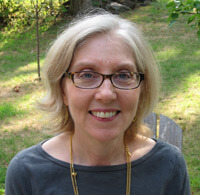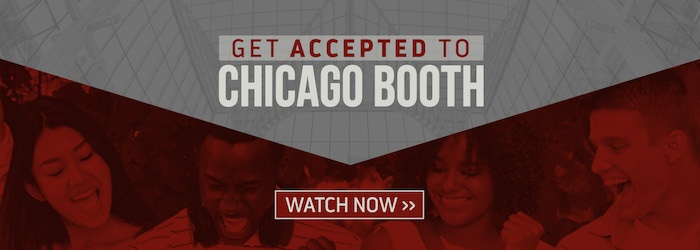

This is part 2 in a series about the “Chicago Approach.” If you missed part 1, check it out here.
Introducing 4 Chicago Booth Students:
Qi: A female Chinese investment banker (who is also a fashion blogger).
Goals: A leadership role in Chinese PE or VC focusing on consumer goods following a stint in private equity in the US.
Jay: An American male clean energy entrepreneur/independent consultant.
Goals: Join a young clean-energy venture still in growth phase, leading its business development.
Sandeep: An Indian male working in global supply chain IT.
Goals: Strategy consulting, with focus on pharma manufacturing.
Marya: A Russian female high school assistant principal.
Goals: Start up an Internet-based language-instruction venture.
As you can see, despite Booth’s reputation as a finance school, it seeks and admits people from a wide range of industries and sectors. From my perspective shaped by 18+ years of experience, these four examples (to preserve confidentiality, these profiles are fictional composites of successful Booth applicants I have worked with, not actual clients) together represent the exciting and impressive scope of admitted Booth students.
They’re not all even quant geeks! So, what do they have in common?
• They all demonstrated in their applications an affinity for rigorous analytic exploration of issues, problems, challenges, and opportunities, for two reasons: they are curious to learn the truth, and they find the analytic process itself exciting. E.g., Jay discussed in his essay how his consulting led him to feel dissatisfied with existing business models for wind and solar power, and since he deeply believed in the need for these technologies, he started to analyze the situation. These qualities relate to the ANALYTIC INQUIRY component of the Chicago Approach (see preceding post).
<< Register for our webinar, Get Accepted to Chicago Booth! >>
• They all conveyed their willingness and ability to grapple with the reality that they find – and it was clear that they are energized by doing so, even when it’s difficult. E.g., while Sandeep was delivering efficiencies in global pharmaceutical supply chains, he learned that a plant in Romania was consistently encountering quality failures. Although product quality failure was not his responsibility, he decided to review the plant’s supply process to verify its integrity, and discovered a sourcing inconsistency due to an ingredient shortage. Along with alerting the senior managers immediately, he talked individually and confidentially with parties involved to learn as much as he could qualitatively about the failure. His reaction relates to the INTELLECTUAL FREEDOM component of the Chicago Approach. While concerned about practical implications and impacts, Sandeep was also driven to understand the actual problem deeply and thoroughly and knew that it wasn’t just formulaic; he pursued different perspectives to flesh out the context. (Aware of the risk of going beyond his own job parameters, in exercising intellectual freedom he applied social IQ so as not to step on toes or raise turf concerns.)
• All these successful applicants presented in their applications (essay, resume, interviews, etc.) positive outcomes they have achieved and constructive differences they have made that were the result of group effort. E.g., while leading a stream of due diligence for a prospective transaction, Qi discovered possible environmental lapses in the African subsidiary of an otherwise attractive company. She convened an informal group of people with relevant experience and knowledge to analyze and provide perspective on the situation and its ramifications for the prospective deal. While the group did not reach consensus on the actual risk, they did agree with her encapsulation of their contrasting findings, which she presented with her recommendation to pursue the deal and factor in cost for environmental remediation – and they agreed to be available should further questions arise. Qi in turn offered to give a “third eye” review of her colleague’s evaluation of the Chinese cleantech sector about which she knew a good deal. This story, portraying the “flow” of group effort as Qi’s modus operandi represents COLLABORATIVE COMMUNITY in the “Chicago Approach.”
While I’ve emphasized one element of the Chicago Approach triad in each of these stories, it’s clear that all these people (and Marya too!) reflect all these elements. Equally important, they have effectively presented that fact in their Booth applications. And given the outcome of those applications, the adcom clearly saw their fit with and understanding of the Chicago Booth MBA program.
I would welcome the chance to help you do likewise in your Booth applications.
 Cindy Tokumitsu has advised hundreds of successful applicants, helping them gain acceptance to top MBA and EMBA programs in her 15+ years with Accepted. She would love to help you too. Want Cindy to help you get Accepted? Click here to get in touch!
Cindy Tokumitsu has advised hundreds of successful applicants, helping them gain acceptance to top MBA and EMBA programs in her 15+ years with Accepted. She would love to help you too. Want Cindy to help you get Accepted? Click here to get in touch!
Related Resources:
• Fitting In & Standing Out: The Paradox at the Heart of Admissions, a free guide
• Chicago Booth MBA Essay Tips & Deadlines
• Focus on Fit, a podcast episode
The post With the “Chicago Approach,” Who Gets into Booth? appeared first on Accepted Admissions Blog.
from Accepted Admissions Blog
https://blog.accepted.com/who-gets-into-booth-with-the-chicago-approach/

No comments:
Post a Comment